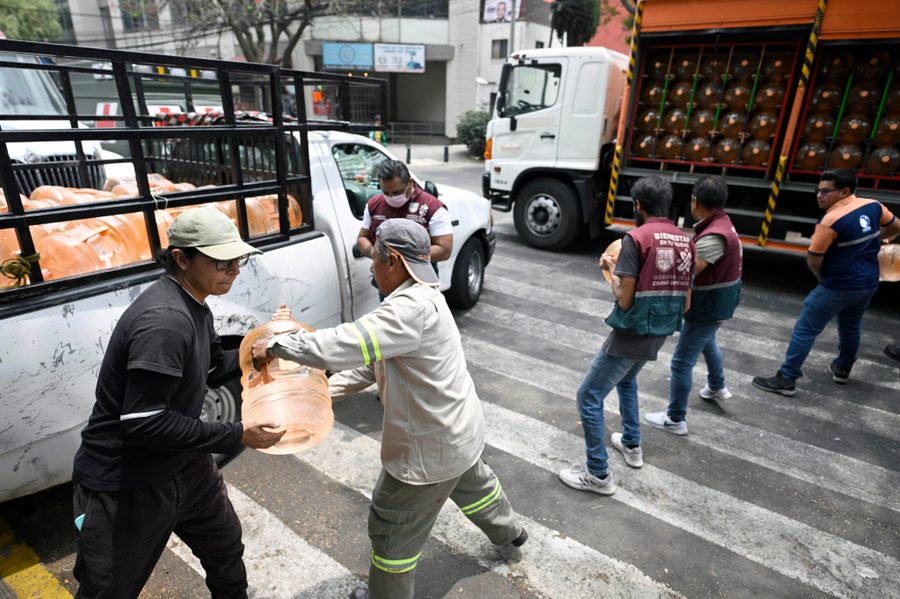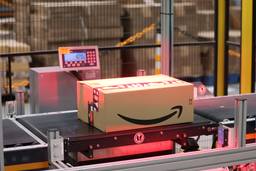A Microsoft AI Data Center Saps Water From A Small Mexican Town
After decades fighting against water bottling and beer companies, rural communities in Mexico are now also having to compete against Big Tech for water.
Maximillian Alvarez

Development in the Global North has long come at the expense of the Global South as well as Black and indigenous frontline communities in places like Cancer Alley and Flint, Michigan. New technologies like BitCoin and AI are no exception, but lack of transparency around energy use in a rapidly changing industry has made many of these so-called externalities hard to quantify, let alone go up against. In drought-stricken Mexico, a new concern arises: are the data centers supporting these technologies taking too much water from already struggling farmers?
In this episode of Working People, as part of our Sacrificed series, we talked to Diana Baptista, a data journalist at the Thomson Reuters Foundation based in Mexico City. She took us three hours outside Mexico City to see the price it takes for us to upload our photos and unread emails to the cloud, and to confront how the increasing reliance on AI may exacerbate water inequality in these newly emerging data center valleys.
This transcript has been edited for length and clarity.
TRANSCRIPT
Maximillian Alvarez: Welcome everyone to another episode of Working People, a podcast about the lives, jobs, dreams, and struggles of the working class today. Brought to you in partnership with In These Times magazine and The Real News Network, produced by Jules Taylor and made possible by the support of listeners like you. Working People is a proud member of the Labor Radio Podcast Network.
My name is Maximillian Alvarez and today we’ve got another critical installment of our ongoing Sacrificed series. In the description of a recent video report titled, “Forget Jobs. AI is Coming for Your Water,” Diana Baptista and Fintan McDonnell write:
“Artificial intelligence lives on power and water, fed to it in vast quantities by data centers around the world, and these centers are increasingly located in the Global South.
“One estimate from the University of California, Riverside says AI’s total water demand by 2027 could be more than half the total annual water withdrawal of the U.K., but all we really have are estimates. Big Tech firms have been secretive about the amount of public water used by individual data centers, and up to half of all data centers don’t even measure how much water they use, according to one survey.
“Colón, a municipality north of Mexico City/in central Mexico, is home to Microsoft’s first hyperscale data center campus in the country. The town of 67,000 is suffering extreme drought. Its two dams have nearly dried up, farmers are struggling with dead crops, and families are relying on trucked and bottled water to fulfill their daily needs. Mexico, leveraging its proximity to the U.S., is hoping to convince big tech to ‘nearshore’ their facilities here. The state of Querétaro is offering favorable land loans, cheap electricity and a pool of local talent.”
Diana, thank you so much for joining me today. I wanted to ask if we could start with the context for the water crisis in Mexico. How bad is it?
Diana Baptista: Thank you, Maximillian. One of the main issues we’re having right now is drought: we have irregular rain seasons, our dams are not filling up. Mexico City came close to reaching Day Zero this year. We didn’t have any plans to overcome it, we got lucky and survived thanks to the rain. Otherwise, around 20 million would’ve been left without access to water.
And because our tap water is not drinking water, the truth is that we’ve become completely dependent on bottled water.
Another issue we have is unequal water distribution. Soda, bottled water, and beer companies – a lot of beer that’s getting exported to the U.S., for example – are located in places with extreme drought, and most of the water there is allocated to them so they can then sell us water in the form of plastic.
Alvarez: I want to circle back to that, how that is the future that lies in store for so many of us – and that future is already here for towns like East Palestine, Ohio. But let’s stay in Colón. What was it like learning about Microsoft’s plans for this massive campus in Colón?
Baptista: We had been investigating the expansion of data centers in the Global South, and suddenly Microsoft made this announcement saying they had invested billions in the state of Querétaro and were opening up a hyperscale cloud region, which the Mexican president was very happy about. And although there’s not enough data on how much water they take, there have been a lot of battles over water around the Global South when these data centers come to town. So we were very interested in the fact that we weren’t hearing anything from activists in Querétaro and decided to make the trip up there.
Colón is a large municipality with car manufacturers and agriculture and other industries. And then you have these small towns where small farmers and people living off tourism actually live. So we went there and people were really struggling.
Most people in an indigenous community called La Salitrera are small farmers or have small restaurants. They live off tourism. The dams were almost completely empty when we went on Father’s Day, which is supposed to be one of their most active days. Everybody had left after a couple of hours and the businesses were all empty. People had nobody to sell their fish or produce to. Nobody was eating at the restaurants. This town’s life is around water. When there’s no water, everything just dies.
Alvarez: It’s hard to determine how much water these data centers are using, but we know usage has spiked since the introduction of AI products like ChatGPT. There’s an article by Yale E360 that reads, “Google’s data centers used 20 percent more water in 2022 than they did in 2021, and Microsoft’s water use rose by 34 percent in the same period.” How has the introduction of so-called AI played into this story and how much water usage are we really talking about?
Baptista: When we first heard that data centers were coming to Querétaro, we asked the companies how many data center units they were planning to build and how much water they would take. Microsoft kept telling us they had no spokesperson who could address that, Amazon said the tech they’re going to use doesn’t need water, and Google just said they’re bringing down their water usage.
We decided to ask the local government because from day one, it has been their priority to bring these data centers to town. On his first day in office, Governor Mauricio Kuri traveled to Washington D.C. to meet with Amazon people to try to convince them to bring their data centers to Querétaro. But when I spoke to the Secretary of Sustainable Development, Marco Del Prete, he said he didn’t have the figures.
We asked the National Water Commission, and they only told us that they haven’t allocated any concessions to any new companies in Querétaro. But one thing about Mexico’s water crisis is that at some point, the National Water Commission gave away a lot of concessions to private individuals and companies. And they can now sell those without having to ask anybody. They’ve been selling them to the industry, and the public is left without water and without knowing who sold it to whom. The National Water Commission told us that’s how Microsoft got one of its commissions.
We tried to figure out on our own how much water these data centers were taking but couldn’t find anything because this information is no longer public once it belongs to a private company. And companies refuse to provide information.
There is a small group of local activists who have been fighting for equal water distribution, and in recent months they’ve been asking the Secretary how much water these data centers are going to take. He always says not to worry, that these data centers do not take a lot of water and that they’re super efficient. But we’re left in the dark about how this supposedly super efficient technology operates. These activists actually had to find out from Context about the concession bought by Microsoft.
Alvarez: Why do these data centers need so much water and why does AI demand so much water?
Baptista: These data centers get very, very hot from all the computing processing, and they need either electricity or fresh drinking water to cool down. But no data center is water-free because the power plants are also running on water.
And what does AI have to do with this? Most of the data centers coming to Mexico are for cloud storage. And as these AI systems grow, these companies are also looking to the Global South to locate their data centers. Experts told us this is for different reasons: local governments are giving them incentives, water and electricity are cheap, there’s a pool of local talent that you can pay less for than you would in the Global North, and then you have all these local governments that are not asking questions. In Querétaro, we even found a contract that the Congress approved for land to be given to CloudHQ.
Alvarez: The average working person doesn’t even seem to know that this is happening, let alone how it’s going to impact them. And they’re not going to benefit from it. Could you talk a bit about what this all looks like or doesn’t look like through the eyes of local working people in Colón?
Baptista: What’s interesting is they’re not even promising that many jobs. The Secretary recognized 2000 direct jobs, which is very little for a $20 billion investment. And these are for people with Master’s or PhD degrees that are not even from Colón who will be commuting from Mexico City or the capital of Querétaro. They’re not going to want to live in these small towns of fishermen and small farmers and restauranteurs.
We were very interested to see what the locals thought about this, and it was funny because you ask them, do you know what AI is? And 70-year-old Mr. Guadalupe Hernández who has a blackberry patch would be like, I don’t know what you’re talking about. But he was very knowledgeable about water inequality. He knows there is new tech, and he knows they’re coming to town and taking a lot of water, and now he doesn’t have enough for his blackberries.
We went to this small restaurant and again, the same story. The restaurant has no electricity or tap water, so the owner has to bring everything from her house. She gets water in her house every eight days, and she fills all these water jugs and carries them on her back all the way to her restaurant. She will tell you she has no idea what AI is, but she knows that she’s struggling and that her business will not survive because there is drought.
Alvarez: We’ve been talking to working folks living in sacrifice zones, where itself is being sacrificed at the altar of corporate greed and profit and technological progress as defined by big tech companies and their supporters in government. And those things become the priorities for government policy in terms of where resources like water are being allocated.
I think you see something in Mexico that still seems very foreign to a lot of people here in the U.S. but is becoming increasingly less foreign, which is, what does it look like when I can no longer trust the water coming out of my tap and I have to live on bottled water? It feels like a reality that we’re just accepting both in areas of the Global South that have been experiencing this for years but also the global working class population.
So doing this research and reporting on these data centers, what do you think it adds to what our listeners here are hearing when we’re talking about sacrifice communities here in the United States?
Baptista: This Mexican government wants tech companies to come to the country because we need more jobs, more investment. We need to grow economically. But at what cost, the dwindling natural resources of the country? And where’s the accountability? For me, the most frustrating part is the lack of transparency. We’ve been told this is because of industry secrecy, but that’s not enough for a population who’s already running out of water. We saw it in Montevideo when activists pushed until they got information and then refused the data center by Google. We saw it in Chile with this wonderful story by Rest of World.
The second part of it is that the arrival of new technology to Querétaro did not benefit the most vulnerable workers in the country. All they’re seeing is their environment changing against them.
We were very sad to see that there was no data, no answers, and no real change for the people who are most vulnerable.
Alvarez: All right, that’s going to wrap things up for us this week. I want to thank our amazing guest, Diana Baptista, for talking with me today and for all the important work that she is doing. We’ll see you all back here next week for another episode of Working People. And if you can’t wait that long, then go subscribe to our Patreon and check out the awesome bonus episodes that we’ve published there for our patrons over the years and go explore all the great work that we’re doing at The Real News Network.
I’m Maximillian Alvarez. Take care of yourselves. Take care of each other. Solidarity forever.
Maximillian Alvarez is editor-in-chief at the Real News Network and host of the podcast Working People, available at InTheseTimes.com. He is also the author of The Work of Living: Working People Talk About Their Lives and the Year the World Broke.











